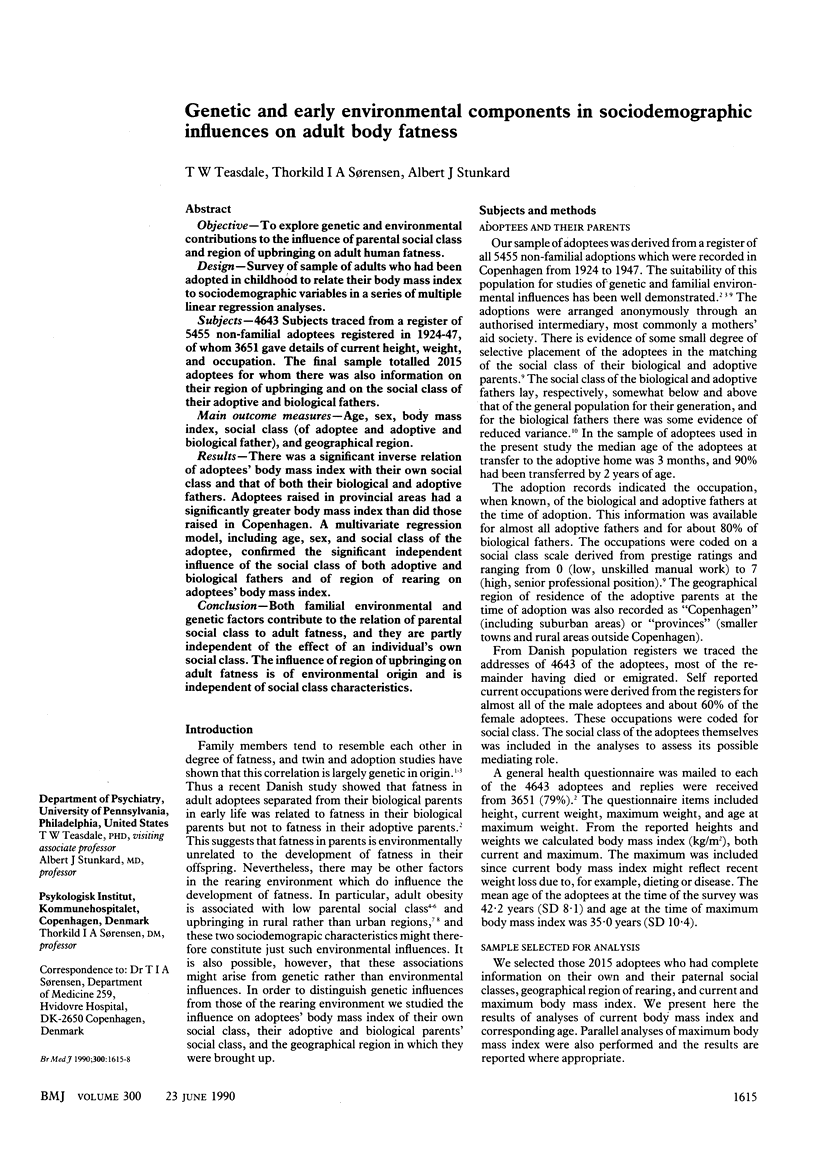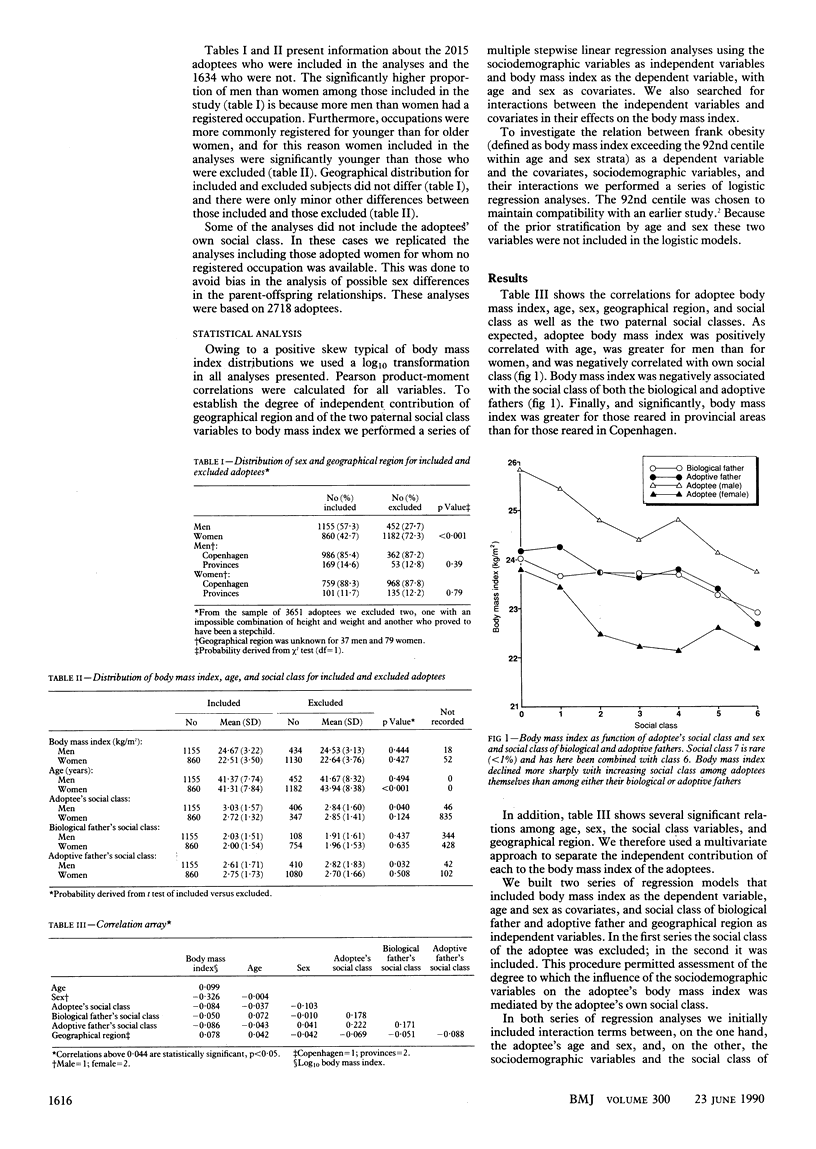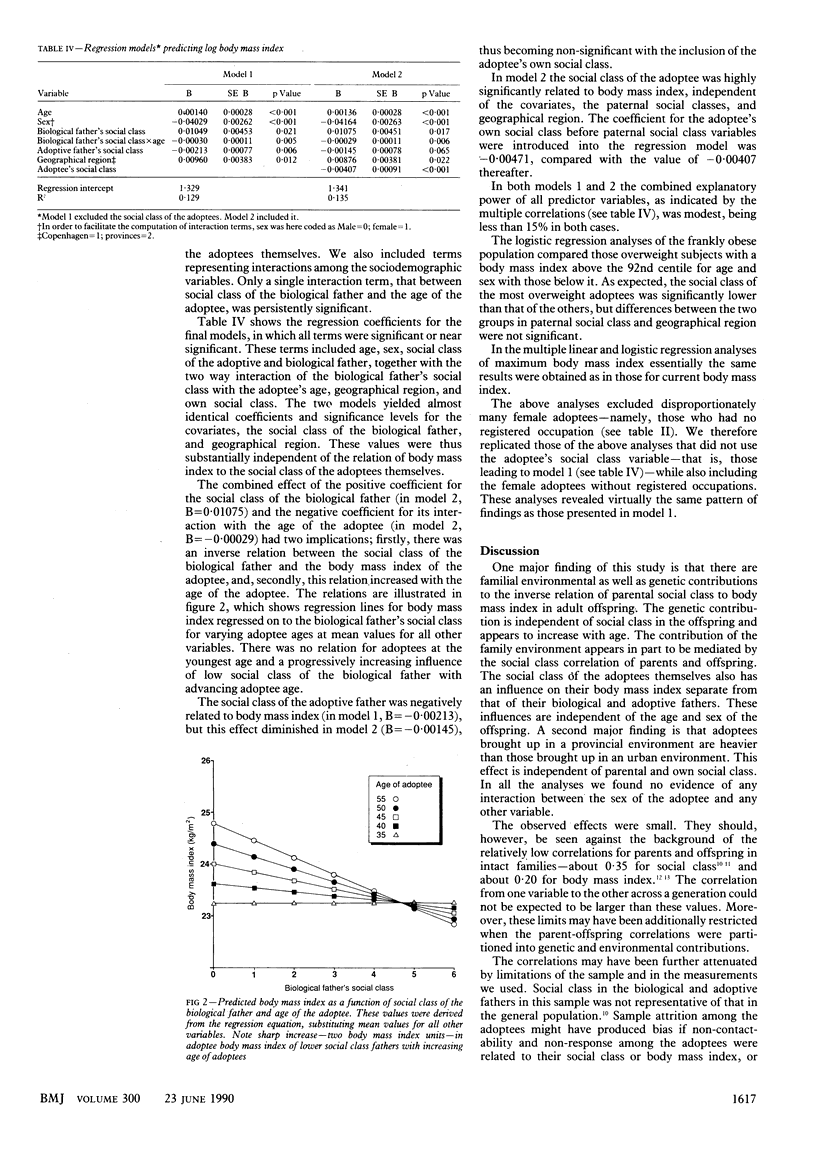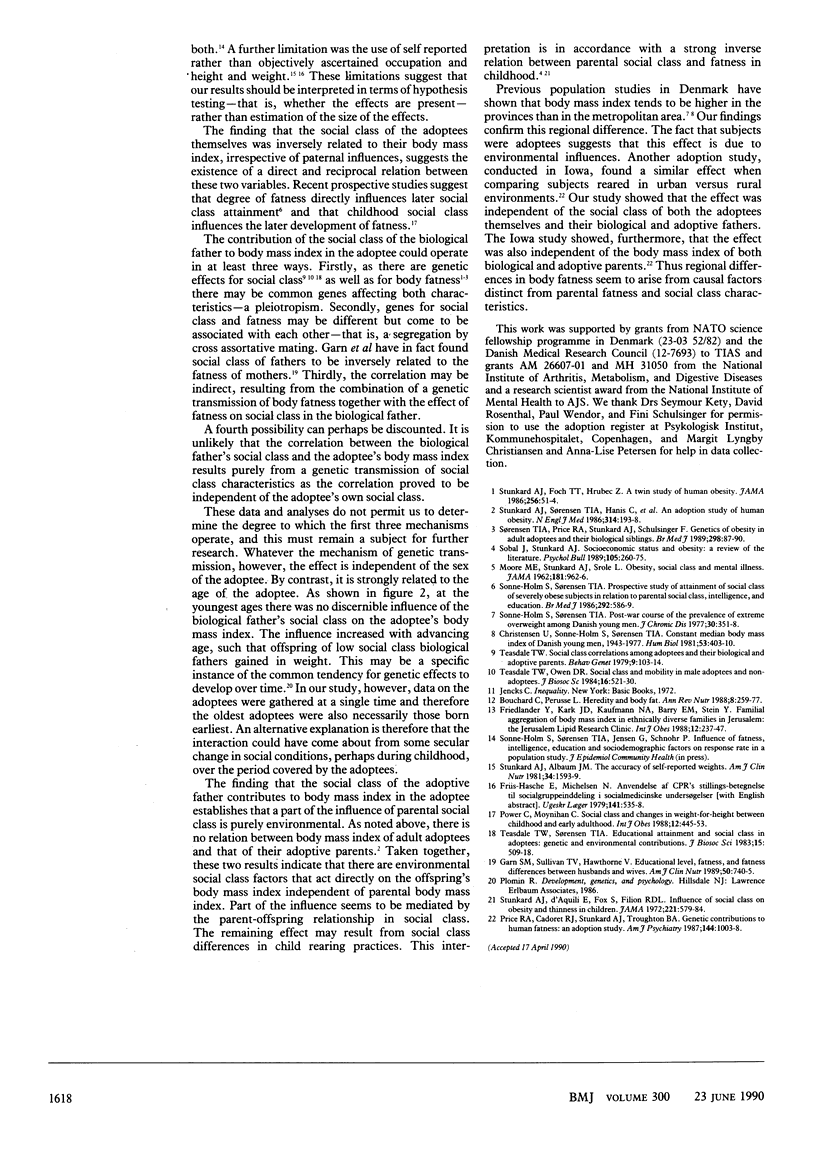Abstract
OBJECTIVE--To explore genetic and environmental contributions to the influence of parental social class and region of upbringing on adult human fatness. DESIGN--Survey of sample of adults who had been adopted in childhood to relate their body mass index to sociodemographic variables in a series of multiple linear regression analyses. SUBJECTS--4643 Subjects traced from a register of 5455 non-familial adoptees registered in 1924-47, of whom 3651 gave details of current height, weight, and occupation. The final sample totalled 2015 adoptees for whom there was also information on their region of upbringing and on the social class of their adoptive and biological fathers. MAIN OUTCOME MEASURES--Age, sex, body mass index, social class (of adoptee and adoptive and biological father), and geographical region. RESULTS--There was a significant inverse relation of adoptees' body mass index with their own social class and that of both their biological and adoptive fathers. Adoptees raised in provincial areas had a significantly greater body mass index than did those raised in Copenhagen. A multivariate regression model, including age, sex, and social class of the adoptee, confirmed the significant independent influence of the social class of both adoptive and biological fathers and of region of rearing on adoptees' body mass index. CONCLUSION--Both familial environmental and genetic factors contribute to the relation of parental social class to adult fatness, and they are partly independent of the effect of an individual's own social class. The influence of region of upbringing on adult fatness is of environmental origin and is independent of social class characteristics.
Full text
PDF



Selected References
These references are in PubMed. This may not be the complete list of references from this article.
- Bouchard C., Pérusse L. Heredity and body fat. Annu Rev Nutr. 1988;8:259–277. doi: 10.1146/annurev.nu.08.070188.001355. [DOI] [PubMed] [Google Scholar]
- Christensen U., Sonne-Holm S., Sørensen T. I. Constant median body mass index of Danish young men, 1943-1977. Hum Biol. 1981 Sep;53(3):403–410. [PubMed] [Google Scholar]
- Friedlander Y., Kark J. D., Kaufmann N. A., Berry E. M., Stein Y. Familial aggregation of body mass index in ethnically diverse families in Jerusalem. The Jerusalem Lipid Research Clinic. Int J Obes. 1988;12(3):237–247. [PubMed] [Google Scholar]
- Friis-Hasché E., Michelsen N. Anvendelse af CPR's stillingsbetegnelse til socialgruppeinddeling i socialmedicinske undersøgelser. En analyse af stillingsbetegenelsen til foraeldre, der har błrn i folkeskolen. Ugeskr Laeger. 1979 Feb 19;141(8):535–539. [PubMed] [Google Scholar]
- Garn S. M., Sullivan T. V., Hawthorne V. M. Educational level, fatness, and fatness differences between husbands and wives. Am J Clin Nutr. 1989 Oct;50(4):740–745. doi: 10.1093/ajcn/50.4.740. [DOI] [PubMed] [Google Scholar]
- Power C., Moynihan C. Social class and changes in weight-for-height between childhood and early adulthood. Int J Obes. 1988;12(5):445–453. [PubMed] [Google Scholar]
- Price R. A., Cadoret R. J., Stunkard A. J., Troughton E. Genetic contributions to human fatness: an adoption study. Am J Psychiatry. 1987 Aug;144(8):1003–1008. doi: 10.1176/ajp.144.8.1003. [DOI] [PubMed] [Google Scholar]
- Sobal J., Stunkard A. J. Socioeconomic status and obesity: a review of the literature. Psychol Bull. 1989 Mar;105(2):260–275. doi: 10.1037/0033-2909.105.2.260. [DOI] [PubMed] [Google Scholar]
- Sonne-Holm S., Sorensen T. I. Post-war course of the prevalence of extreme overweight among Danish young men. J Chronic Dis. 1977 Jun;30(6):351–358. doi: 10.1016/0021-9681(77)90029-7. [DOI] [PubMed] [Google Scholar]
- Sonne-Holm S., Sørensen T. I. Prospective study of attainment of social class of severely obese subjects in relation to parental social class, intelligence, and education. Br Med J (Clin Res Ed) 1986 Mar 1;292(6520):586–589. doi: 10.1136/bmj.292.6520.586. [DOI] [PMC free article] [PubMed] [Google Scholar]
- Stunkard A. J., Sørensen T. I., Hanis C., Teasdale T. W., Chakraborty R., Schull W. J., Schulsinger F. An adoption study of human obesity. N Engl J Med. 1986 Jan 23;314(4):193–198. doi: 10.1056/NEJM198601233140401. [DOI] [PubMed] [Google Scholar]
- Stunkard A., d'Aquili E., Fox S., Filion R. D. Influence of social class on obesity and thinness in children. JAMA. 1972 Aug 7;221(6):579–584. [PubMed] [Google Scholar]
- Sørensen T. I., Price R. A., Stunkard A. J., Schulsinger F. Genetics of obesity in adult adoptees and their biological siblings. BMJ. 1989 Jan 14;298(6666):87–90. doi: 10.1136/bmj.298.6666.87. [DOI] [PMC free article] [PubMed] [Google Scholar]
- Teasdale T. W., Owen D. R. Social class and mobility in male adoptees and non-adoptees. J Biosoc Sci. 1984 Oct;16(4):521–530. doi: 10.1017/s0021932000015340. [DOI] [PubMed] [Google Scholar]
- Teasdale T. W. Social class correlations among adoptees and their biological and adoptive parents. Behav Genet. 1979 Mar;9(2):103–114. doi: 10.1007/BF01074329. [DOI] [PubMed] [Google Scholar]
- Teasdale T. W., Sørensen T. I. Educational attainment and social class in adoptees: genetic and environmental contributions. J Biosoc Sci. 1983 Oct;15(4):509–518. doi: 10.1017/s0021932000020964. [DOI] [PubMed] [Google Scholar]


